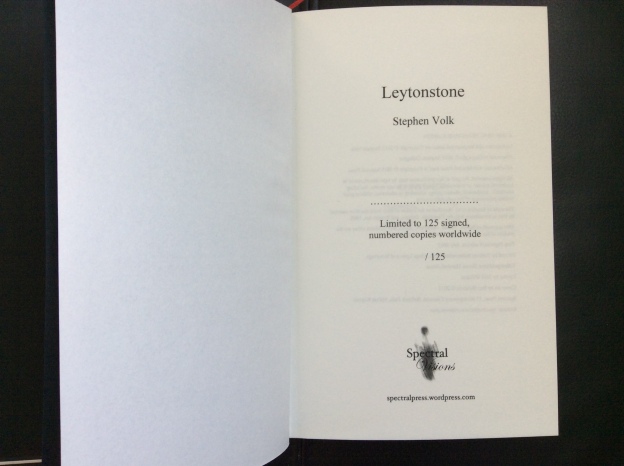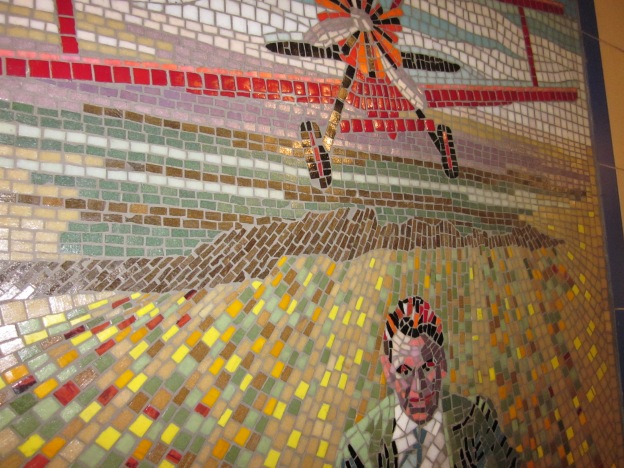Leytonstone – Stephen Volk



Received at last this purchased hardback book…
Spectral Visions 2015
My previous reviews of Stephen Volk works HERE.
When I real-time review it, my comments will be found in the thought stream below or by clicking this post’s title above.
All Leytonstone’s Hitchcock Mosaics are photographed for this review by PF Jeffery.

“He accompanies his father up a flight of stone steps in through a swing door under a blue lamp.”
Like Fred, my Grandmother was born in 1899 in East London, and as we meet Fred In this book’s already highly atmospheric time and place, they are seven, and I wonder if they ever met….
Caught straight in, I am, with Fred’s incantation of potato types alongside his Mum in their greengrocers – and then taken to the police station by his father for what I can only dare anticipate as being a sharp lesson in discipline. I hate to think Fred has really done something wrong…
How can that world I once heard about so often from my beloved grandmother be so beautifully evoked in such a few initial pages?
All Leytonstone photographs for this review are by PF Jeffery (author of JANE).
“Footsteps, keys, more footsteps, fainter — then not even that.”
It was definitely worth waiting for this book. The year 1906 has come alive in my hand, the mores of these people. The telling of Grace. The swallowing of a pint. The ‘common’ women as well as the less common ones. The smell of bodily fluids. Poor Fred languishing in his cell, the noises, the overtly cruel (implicitly kind to be cruel but cruel all the same) policeman. Fred’s seven year old character (“travelled on every tram in London!”) already building by dint of neat dialogue…as he refutes every crime he could have done.
“Everything — everything — is a mystery.”
“
“That not sleeping sends you mad, and he wonders how long it might be before he goes mad.”
Fred’s backstory at seven is adumbrated as he escapes from the experience of enforced guilt – a beautiful passage about a ‘porcelain martyr’ mother figure in telling contiguity with a potential Joycean epiphany of the Christ figure and the Christian ‘Hell’ imbued while at school with teaching by Priests, self-referred pain as flinching echoes, the opening eye of the opposite sex, the smell of bacon, the taste of Eucharist, the sounds of the city… All exquisitely done. Even a hint of Fred’s physique.
“Does everybody else taste something, and is it only he who does not?”
“He is on the run — but he’s not sure what he’s on the run from, or why.”
On the copyright page of this book: ‘This is a work of fiction. Names, characters, places and incidents either are the product of the author’s imagination or are used fictitiously.”
That gives me a truth’s frisson of fiction about Fred, as was his earlier imprisonment as a seven year old, now fictionalised as his own nightmares that feel real when he is dreaming them. Treasure Island and Great Expectations his reading, a cross of truth and fiction, that cannibalistic Magwitch, Jack the Ripper (“Did he dress as a woman?”), all mingled with the image of Christ … and his parents’ inchoate marriage where Fred is either intruder or idol.
“The sort of game he played in the playground with his friends? Do grown-ups play those games?”
A cross-section of discovery, exploring derelict houses where omniscience is significantly withdrawn, plus pranks and cruelties, the secret of sex and other gestures, patterns of behaviour between girls and boys, adults and children, like being haunted by that prison’s policeman again as tenuous as a holy wafer…
Squint holes and symbols…
A gestalt of such things that reminds me fruitfully, if obliquely, of much childhood-based Truman Capote fiction, where filters work both ways.
“Eyes fixed on the pavement ahead he walks home past a large poster on a wall advertising the local skating rink, with a smiling woman…”
Fred interfaces with the yellow-haired girl via mock mouse as thumb in a matchbox, with its own squint hole, later developing to binoculars aimed at her atmospheric back to back across the smoky tracks…
Stitched by font and knowledge of all the bus and train routes mapping out around him towards a gestalt or genius loci…
This is beautifully evocative of the budding Fred and his ‘objective correlatives’ that we might see develop into his later skills and obsessions…
I mean this as a huge compliment – ‘Leytonstone’ is a book that reminds me of the near-contemporary fiction we were given in the 1960s at school to study at O Level English Literature. It has that old-fashioned modernity.
“Sometimes it seems no amount of applause is enough for his dear old mum.”
From the ‘carousing’ in the pub (that policeman again who imprisoned our friend Fred) and the cockney banter and his Dad’s behaving fast and loose with sexual loose ends, as it were, followed in another scene by a personal Old Variety Hall performance by his Mum in his bedroom, poignantly portrayed …
But this section also makes me wonder if the text is beginning to be overburdened with features of local atmosphere of the times, as if often thrown in for its own sake or over the top.
All can be forgiven, though, with the contrasting and revealing scene featuring the logical questions that Fred innocently asks the Priest. And the knowing and telling transference of this book’s ‘squint hole’ leitmotif to the sole of a shoe…
“But Joseph wasn’t the father, was he? So Mary sinned. With God.”
“You know where you are with books. Books are the same every time you open them.”
… unless it is an ebook with fluid pages, unlike this hard covered, red-ribboned, stiff-paged, unsigned artefact I am reading. “As if shut away in the pages of a closed book.”
This book is not always the same, though, as it now takes on a new inimical life, irresponsibly and cruelly closing up one of its characters inside its catchment area – the yellow-haired girl – as if Fred herself trapped her in it like Poe’s eye under the floorboard. Or a mouse in a matchbox. They’d just been to those ‘Pictures’ that I used to go to in the 1950s onward, thirty years or more after when the characters here went to see them. I sometimes went to see Hitchcock films. I wonder what these characters went to see.
I sense the fiction here has subsumed the reality and made it seem even more real, just as Hitchcock’s films strived to do. This book, too.
There’s always an extra character like D’Artagnan. Fred just needed to prove he was not scared. And to be able to scare others. But sometimes it goes too far.
Caveat – Some brainstorming of mine above within as well as without the book.
“Dervishes to the right of them. Dervishes to the left of them.”
Only special fiction can carry such strength to alter perceptions of truth and fiction. The warning is for us as much as for anyone in the book, I sense. Or am I too sensitive? Shouldn’t fiction be allowed to work like that?
With correlative lessons….
“A doe that intuits the arrow of the hunter.”
A black funeral barge, a tell-tale heart, Catholicism as guilt, sacred heart as guilt, punishment as guilt not punishment, carousing with Devils… Being told what you are makes you what you are?
These things make me feel Fred’s guilt about his actions in myself. Guilt as a sort of madness.
Prose and dialogue cleverly laced with italicised rhymes of the time throughout.
“In his mind’s eye. In his camera mind…”
Still seven year old, Fred’s release as if of a bird-scratched woman later emerging back info life from an attic…
The scores of sin.
Then Empire Day.
“He wishes he could stop her fear, but he can’t. He can’t even stop his own”
“All night if she has to. In the dark. Like he had to.”
“Good. Evil. The machinations of a small child’s mind and soul. The perplexity of it. Where it begins and ends.”
Denouement, except, for me, there are more knots tied than untied. Amazing scenes, one with a church authority, other, yet unresolved, with secular authority (e.g. police), and it reverberates with today’s active scandals of historic guilt and allegation between the genders but it is in our day inverted if not perverted for the famous turned infamous. A genius comparison and potential resolution by this allegedly fiction text. Also a genius enthralling slant upon a moment in the childhood of someone who later was due to become famous…
It all sort of meshes, leitmotifs into gestalt.
But I still have one more section to read.
“Soon it begins.”
“Soon it begins, and never ends.”
end